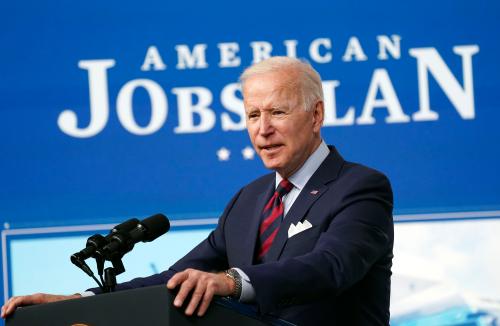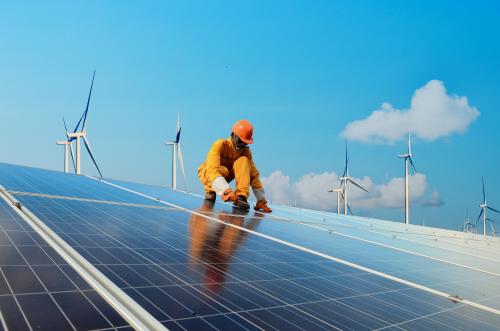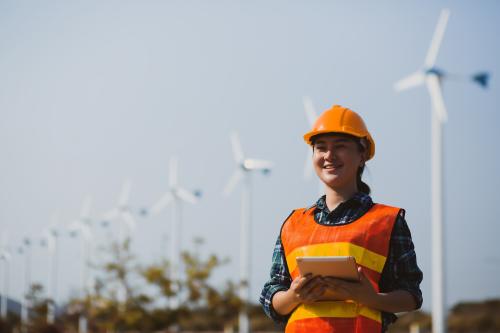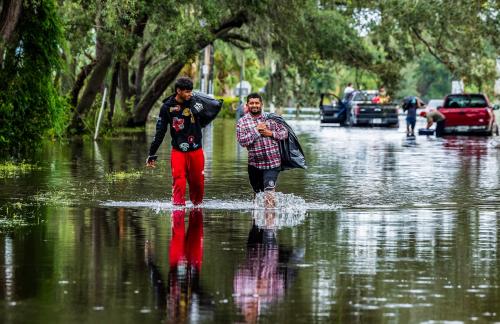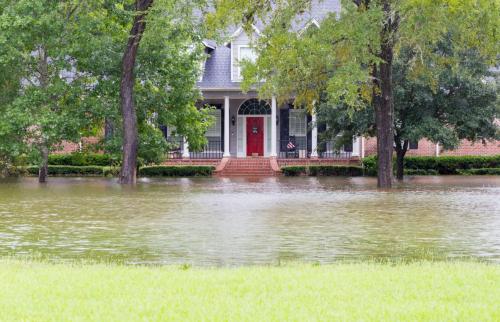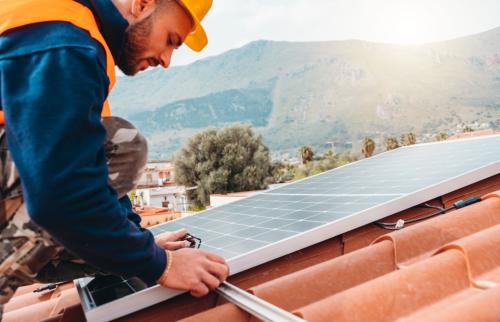After declaring the climate crisis to be a top priority of his administration, President Joe Biden recently solidified his greenhouse gas (GHG) reduction targets as part of a major global summit. The national goal is to reduce GHG emissions to 50% of the amount emitted in 2005 by 2030, with an even bigger goal of net-zero emissions by 2050.
The targets are necessary and ambitious. They also will require a set of systems-level changes across every sector of the economy. But there’s a problem. The administration’s high-level strategy skimmed over a central driver of our climate crisis: unsustainable land use practices.
Simply put, the United States cannot reach its GHG reduction targets if our urban areas continue to grow as they have in the past. After decades of sprawl, the U.S. has the dubious honor of being a world leader in both building-related energy consumption and vehicle miles traveled per capita. Making matters worse, lower-density development also pollutes our water and requires higher relative emissions during the initial construction.
That leaves the country with no choice: We must prioritize development in the kinds of neighborhoods that permanently reduce total driving and consume less energy. Such human-centered neighborhoods have the added benefit of helping us adapt to climate impacts, improve public health, and promote access to activities. Encouraging their development should be a central part of any national climate resilience strategy.
This won’t be an easy task. Fundamentally changing where and what we build requires new ways of planning and investing in our communities. Since the federal government doesn’t directly control local land use, changing where we live and how we get around will require buy-in from states and local governments that manage zoning and other regulations, real estate developers who lead construction, and the finance industry that underwrites it all. With little time to waste, the U.S. must begin testing and scaling policy levers than enable a more resilient approach to regional development.
Decarbonizing electricity is essential—but insufficient
Among its various climate concerns, the U.S. is one of the world’s largest GHG emitters, even with aggregate drops of over 12% since 2005. To make even bigger cuts over the next decade, the Biden administration is betting on a two-step process: aggressively decarbonizing how we generate electricity and then switching as many activities as possible to clean electricity. This promise to adopt a “clean electricity standard” is a great approach for a few reasons.

For the first step, the electricity generation sector is already a national decarbonization leader (Figure 1). Between 2000 and 2019, the electricity sector reduced its total GHG emissions from the fuels it burns by 33%. Utilities are retiring coal-fired power plants, often replacing them with renewable energy sources such as wind and solar. The continued drop in costs to build and operate renewable power plants should only further incentivize this transition.
Advances in a sweeping set of manufactured products can then help the American economy achieve the second step. Heating, cooling, and water management within our buildings can all turn to electrical equipment. The same goes for other building-related appliances, even if some may forever prefer to cook over an open flame. Even the equipment associated with many heavy industries can increasingly use electrical currents.
The biggest categorical target, though, is electrifying our transportation sector—especially consumer vehicles and small trucks. As the country’s top GHG-emitting sector, eliminating gasoline from the transportation sector is essential. So while electric vehicles (EVs) only comprise 2% of new light-duty vehicle sales, rising demand among large fleet owners (including the U.S. Postal Service) and private households is aligning with the commitment among automakers to boost EV production.
This two-step process benefits from scientific and manufacturing innovation, but the sector’s governance helps ideas scale. There are a relatively small number of energy utilities across the country, and utility regulation is primarily handled at the federal and state level. Federal law can create clean energy standards among appliance and vehicle manufacturers. States can mandate clean energy building codes. Electricity generation and transmission is an ideal area for top-down regulation.
But for all the possibilities, climate scientists freely admit that decarbonizing electricity generation will not meet all of our 2030 carbon targets—and certainly does not touch all of our broader climate goals. Some electrical appliances continue to emit harmful pollutants (at least for now). Natural gas plants have been a big part of bringing down utilities’ GHG emissions, but their methane-related byproducts are not yet under control. A decarbonized electricity sector also doesn’t respond to a range of other climate-related challenges, from unsustainable water management and coastal erosion to urban heat islands and agriculture-related emissions.
Nor are EVs perfectly clean, and that’s assuming the entire country suddenly runs on zero-emission electricity. Manufacturing vehicle-grade batteries is still an inherently dirty process, especially the global mining of rare earth minerals such as cobalt. Building EVs will still generate GHG emissions if processes such as steel production aren’t decarbonized. Plus, the simple act of driving leaves an environmental footprint, including the rubber particles from tires that are now found in oceans. It’s a myth that EVs are as “dirty” as vehicles with internal combustion engines, but they’re also not perfect.
Car-dependent neighborhoods restrict multiple climate goals, including GHG targets
A clean electricity standard is an essential step for the country, but it doesn’t address our land use issues. Car-dependent neighborhoods lock us in to a baseline of harmful emissions while creating other climate impacts in the process.
Vehicles present an eternal and unsolvable geometric challenge: They require significantly more space per person than any competing mode of transportation. Figure 2 displays two Kansas City, Mo. neighborhoods with a similar number of residents and jobs; one was built before the mass adoption of the automobile, and the other was built decades later. The comparison shows an enormous difference in how humans approach land use: While earlier neighborhood models were built around mass transit such as streetcars and at distances friendly for walking and cycling, newer neighborhoods frequently design all real estate to accommodate the automobile.

Metropolitan America has spent decades shifting the vast majority of economic activity to car-dependent neighborhoods, leading to greater per-person land consumption and more driving. Between 1960 and 2010, U.S. urban land area grew at a rate 1.7 times faster than population growth. To connect all the housing and activities spread across so many more square miles, the average American’s daily travel mileage grew by 85% between 1969 and 2017. Looking at detailed data in six major metro areas, we found the average trip exceeded 7 miles.
This kind of regional development has significant climate consequences, even if we assume all vehicles are running on clean electricity. Low-density neighborhoods require more physical capital per person, meaning more building materials and emissions to manufacture concrete, asphalt, piping, and other material inputs. All that concrete and asphalt radiate heat back into the atmosphere and can reduce public health due to higher temperatures. The same impervious surfaces also lead to water resource challenges such as greater stormwater runoff and flash flooding. In the most extreme situations, sprawling development moves into areas prone to flooding or forest fires.
Car-dependent development—combined with local zoning that prohibits higher-density housing—incentivizes less energy-efficient building designs too. Detached buildings, including single family homes, miss out on the energy efficiencies of shared walls. Car-dependent neighborhoods are also associated with bigger homes, meaning more square footage to climate-control and higher utility bills for households. Commercial and industrial buildings with large area footprints and low heights require more energy to heat and cool. Clean electricity and weatherization can help, but the overall inefficiency is structural.
One way to see the net effect of neighborhood design is to map carbon footprints. Advanced modeling, such as the below map from the University of California, Berkeley, consistently finds higher GHG and other pollutant intensity per capita in many suburban neighborhoods when compared to older urban cores.

Add it all up and metropolitan America—where over 86% of people live—is awash in missed opportunities. Biking and walking produce nearly zero emissions, but we’ve built neighborhoods that either make distances too long or travel paths too unsafe. Transit can be more energy-efficient for longer-distance trips, but the geometry of car-dependent neighborhoods limits demand for buses and trains. We know “gentle density” offers sizable housing units while still promoting energy-efficient buildings and transportation behavior, but we’ve prohibited smaller structures on the majority of land in metropolitan areas. We even know which geographic areas are prone to more chronic and acute climate shocks, but we continue to subsidize development in those areas.
To build resilient regions, we need better functioning markets and more policy coordination
There are thousands of real estate developers, almost 40,000 local governments, and over 100 million households that all have some level of individual control over where we develop land, what we build on it, and how we choose to travel over it. The country needs a new approach to land development—coordinated from the federal to local level, tapping each level’s unique jurisdictional authorities—to push those key actors to behave in more climate-friendly ways.
That will require at least two areas of action:
- Use market principles to send climate-sensitive price signals. Real estate developers, lenders, and households will make more resilient investment decisions if they understand the climate-related costs of their decisions and bear some brunt of the financial impact. For example, charging higher mortgage interest rates or increasing insurance premiums could steer development away from sensitive areas. It also works in reverse, as federal or state incentives could encourage more resilient development patterns, such as conserving land and incorporating greener designs.
- Use statutory authorities to scale policy adoption. The federal government doesn’t directly control land use, but it has several policy levers to influence it, including flooding and disaster insurance, Fannie Mae and Freddie Mac’s lending rules, the location and quality of transportation investments, and environmental permitting laws. Federal rules—whether done through a carrot or stick approach—can push states, fragmented metropolitan areas, real estate developers, and households to act in predictable, sustainable ways.
The country does not lack innovative policy ideas in the land use space or the ability to craft new ones. Climate-focused procurement reforms, land value taxes, statewide zoning reform, and safe streets policies are just a sample of what’s available to test or scale. But those policies will only maximize their impact if they become the default toolsets for how we develop metropolitan America.
Overcoming the climate crisis requires addressing land use
There’s a sense that electrifying our transportation sector and in-home appliances may be enough, but metropolitan land use demands other systemic changes. We need to undo decades of bad habits, returning to traditional people-centered neighborhood designs and incorporating forward-looking building technologies that promote more sustainable and equitable living. It’s a generational lift—and time is running out.
Statements of intent are important signals, and don’t cost politicians much. It’s imperative that our national leaders start naming land use challenges when they discuss our climate future. But we can’t afford to stop there. America needs federal leadership to test ideas and scale solutions. Land use may be local, but our climate future is shared.
The Brookings Institution is committed to quality, independence, and impact.
We are supported by a diverse array of funders. In line with our values and policies, each Brookings publication represents the sole views of its author(s).





